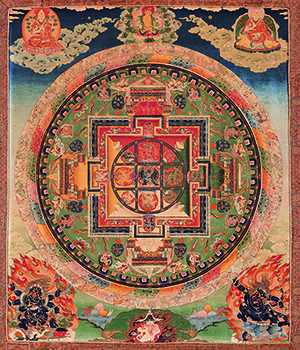Mandala
Mandala means “circle” in Sanskrit, the ancient language of India, and the term represents both the worldview of Buddhism born from esoteric Buddhism in Indiaand the place where the Buddha lives. The ultimate goal of Buddhism is to achieve spiritual enlightenment—that is, to become a Buddha. A mandala can be described as a kind of rough sketch created for that purpose.
In Tibet, esoteric Buddhism was adopted from around the mid-11th century, and numerous types of mandalas were introduced from India at that time.
A mandala consists of the circle and the square, the two most stable shapes. These shapes reflect the structure of the universe.

Yamāntaka Mandala, Tibet
17-18 century / Panel, color on cotton / 61 x 51.5 cm / Kitamura Collection
* To be shown between Oct. 19 and Nov. 29
There will be the changes of exhibits.
Please refer here for complete information with regard to the changes of exhibits.
■Relevant Information
・The Universe and Art: Princess Kaguya, Leonardo da Vinci, teamLab
July 30, 2016 - January 9, 2017
・MAM Screen 004: Watching the Earth from the Universe
July 30, 2016 - January 9, 2017
・Welcome to “the portal to the universe”!
―“The Universe and Art” work #1: teamLab
―“The Universe and Art” work #2: Meteorite Sword
―“The Universe and Art” work #3: Patricia Piccinini
―“The Universe and Art” work #4: Utsuro-bune (hollow ship)
―“The Universe and Art” work #5: Mori Mariko
―“The Universe and Art” work #6: Mandalas
―“The Universe and Art” work #7: Tom Sachs
―“The Universe and Art” work #8: Semiconductor
―“The Universe and Art” work #9: Galileo Galilei Sidereus Nuncius
―“The Universe and Art” work #10: Björn Dahlem
―“The Universe and Art” work #11: Jules de Balincourt








